Colour-switching sticklebacks, geckos with enough adhesive power to hold up a human, bats with built-in sonar and moles with amazing noses - this week we go in search of the world's most incredible animals. Scientists passionate about their species put their cases to our panel. But which animal will be crowned king?
In this episode
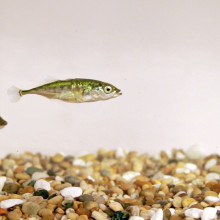
02:03 - Surprising sticklebacks
Surprising sticklebacks
with Jolle Jolles, Department of Zoology, Cambridge University
This week we're asking what's the most amazing animal. Kicking off the competition with Ginny Smith, and putting forward the case for the stickleback, is Jolle Jolles who's a PhD student at the department of 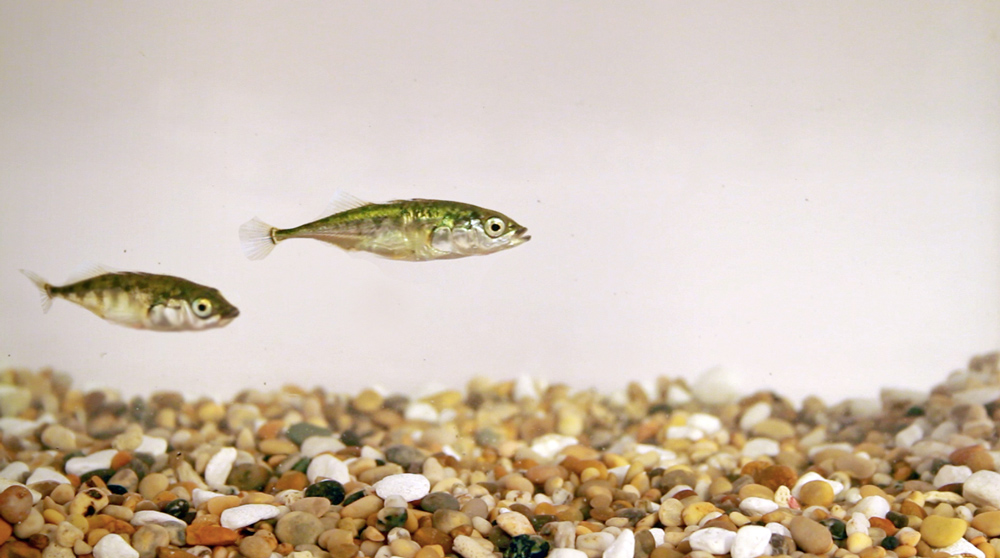 zoology at Cambridge University...
zoology at Cambridge University...
Jolle - I'll be talking about the three-spined stickleback, which is a small little fish that can be found throughout the UK and the northern hemisphere.
Ginny - And you've actually brought some sticklebacks with you today. Is that right?
Jolle - Yeah, exactly. Let me show you.
Ginny - So, you've got here a see-through plastic box and in it are two tiny little fish. They're only about maybe an inch and a half long and they're sort of goldy colour. They've got big eyes and I can see their little fishy mouths going blob, blob, blob. They look like nice enough fish, but they don't look hugely amazing to me at the moment. Are you going to try and convince me differently?
Jolle - Yes, definitely. What is quite cool about this fish is they have these really elaborate breeding displays. So, the male, they make this nest in the river, tries to get a female and becomes really red during their breeding season to impress a female. What they then do, they have this really cool zigzag dance, after which, the female hopefully for the male delivers the eggs. What is really cool as well is that these male sticklebacks are really good fathers. They not only defend the nests from predators and other sticklebacks, but they actually carry the young in their mouths when they go too far from the nest. What is also really cool is these fish actually have personalities. And thinking like, how can animals have personalities? Well, they have really consistent behaviours. So, you can imagine like some people take a lot of risks and others are really shy. Some are really social and some other fish might be quite solitary. But this is exactly what we find in the fish as well. What I'd like to show you today is some really cool aspect of this fish namely, although they look very ordinary, they can change colour. And not only that, they can change colour in this next hour. What I have behind me here is a couple of buckets, different environments that the fish might see in the world.
Ginny - What can you see there?
George - In the white bucket, I can see little white pebbles and in the black bucket, I don't really see anything except plain water.
Ginny - So, in the bottom of the black bucket, it's quite hard to see but there's actually some black sand in there. Is that right?
Jolle - Yeah, that's correct. When they're in the wild, they can sometimes live in these light streams where there's not a lot of cover and it's white sand. But other fish population may live in these really dark streams. And sometimes fish might actually encounter both. So, it might be helpful for them to actually be able to change colour.
Ginny - So, I guess these are quite small fish. I can imagine they're prey for quite a lot of different things.
Jolle - Yeah. Actually, 50 different predators have been described. Think about birds and fish, but actually, did you know that insects can actually predate on these small sticklebacks. So, there's many species that adapt to their environment and they look like their environment. So, this is something you can find throughout the animal kingdom. But there's actually not that many species that are able to adapt very quickly and they change colour. This is what I'd like to show you tonight.
Ginny - So, we're going to actually see some sticklebacks change colour?
Jolle - Hopefully, yes. In an hour, you'll see which fish will be in the white bucket and which fish will be in the black bucket.
Ginny - Should we get it setup then?
Jolle - Definitely, yes. Let's go. So, what we have here is just three buckets. There's a nice big bucket with greyish gravel and a nice plant for them for cover. There's 10 fish in there and what I will do, I will put 5 fish in the black bucket and 5 fish in the white bucket.
Ginny - Okay, so we've got 10 of these fish that are all the same colour. They're this sort of light brownish, greyish, goldish colour - I think it's probably the best way of describing it. And we're going to hoik them out with a little net and put them in the different buckets. They are quite hard to see. They're very well camouflaged against that sort of greyish brown gravel you've got in the bottom of that bucket.
Jolle - Exactly. They have been in this bucket with the brownish gravel for an hour now and it's hard for me to even find them. So hopefully now in an hour, we'll see that they actually change colour.
Ginny - So, how do they actually change colour? What is it that's going on inside the fish?
Jolle - Well, so for this very rapid colour change, what happens in the cells of the fish, they have these pigments in these cells called chromatophores and the pigments can be either dilated or contracted. If the pigment comes together, they might look much darker than when it's dilated. But when you put fish in different environments for longer periods of time, actually, these cells and the pigments starts to really go away. So, it's a totally different process when that happens on a short time scale versus a long time scale.
Ginny - So, is it similar pigment that gives us say, brown hair versus blond hair - the same sort of idea?
Jolle - Yeah, it's very similar indeed, yeah.
Ginny - But they can actually control that. So, that will be like me being able to say, I quite fancy being blonde this evening.
Jolle - Well, it's not really like that.
Ginny - Disappointing.
Jolle - Yeah, it would be great, wouldn't it? The way it works actually is that it's based on the vision of the fish then sends a signal to the small brain of the fish and then autonomously the cells start to change the pigment.
Ginny - So, it's an automatic reaction based on what's around them that makes them blend in.
Jolle - Exactly, yes.
Ginny - And do all fish change as quickly as each other or does it differ between different fish?
Jolle - This comes back to this personalities I talked about before. Namely, these bolder fish that take a lot more risk, they're not as responsive to their environment and it takes it much longer to change colour to blend in to their environment. Amazing, isn't it?
Ginny - It really is. I'd never heard of fish that could change colour before. It's fascinating! Thank you so much. Now, we'll be coming back to Jolle later to see how his fish have got on. But first of all, let's go over to the judges. What did you think of that, Georgia?
Georgia - Thank you, Jolle. Well, when you put those fish out, I thought they look so boring, like maybe I'd eat one. But after your talk, I think I'd actually quite like to be one. They have personality, they make good fathers, and I think I really like the idea of a man turning red to impress me. I might need to revise my score later if I see you running around with paint later, but for now, I'm very impressed.
George - I think you explained it quite well, but I was wondering about, you said they try to impress mates, do they end up having to fight over mates?
Jolle - Yes, they do. When the breeding season starts, the temperature of the water rises, the light increases and this elicits this red coloration in the males. And this acts like a sign stimulus. So, whenever other males see this red colour, they immediately become aggressive. So, all these males try to get their own territories and if they fight with one another to defend their nest and hopefully, get the best female that is around.
Ginny - Okay, so now, our judges have their scores. Over to you guys...
Georgia - 7.
Max - 6.5
George - 8
Ginny - A strong score to start with and as I say, judges will have a chance to revise their scores later, depending on how well the fish change colour. No pressure Jolle. Let's have a huge round of applause for Jolle Jolles from Cambridge University.
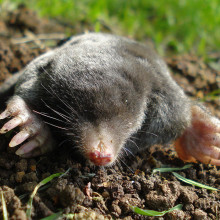
09:30 - Marvellous moles
Marvellous moles
with Dr Nick Crumpton, Natural History Museum, London
This week we're asking what's the most amazing animal? Talking to Ginny Smith, Nick Crumpton from the Natural History Museum, did his PhD on moles.
Nick - For starters, how about their strength? Now, these animals are pretty incredible. They are super strong. If you have a look at their arms, you open up their arms and have a look at how big the muscles are, they're absolutely ginormous. Now, their humorous bone which is the top of your arm, that's actually as wide as it is long. And that's all for muscle attachments. So, these guys are really, really strong indeed. Now, we know that some species of moles can exert a force that's 24 times their body weight. Now, that's like a 12-stone person. It's a little bit more than me, like moving a 1.8-ton block. Now in addition to that, think about where they live. These guys live under the ground. They live in tunnels. So, that not only means that you have to move all that soil out of the way. That also means that you've got to make a living where you can't see but also, where breathing is actually really, really difficult. We know that the concentration of carbon dioxide in tunnels is 10 times greater than it is at the surface. We also know that the amount of oxygen found down there is less than half what we're used to breathing. Now to deal with that, that means that moles actually have twice as much haemoglobin in their blood. So, haemoglobin is the stuff that makes your blood red and it's the stuff that actually soaks up oxygen into your body.
Ginny - Moles are well-known for being blind. Being blind doesn't sound that amazing to me. What's so good about them?
Nick - Oh Ginny, that's because you've got such amazing eyes. You are using them all the time and there are lots of other ways that you can find your way around without using the eyes. There are an awful lot of blind animals. But moles use their tactile sense.
Ginny - How good is their sense of touch compared to say, yours or mine?
Nick - The front of their face is more sensitive than our fingertips.
Ginny - So, we've got a little demo to do to show you just how sensitive your fingers are and what it might be like to be a mole. What's your name?
Gavin - Gavin.
Ginny - And how old are you?
Gavin - 9.
Nick - So, I've got some stuff in this sack right here. We've got some objects and you're not allowed to look at them. So, I want you to maybe - look at the audience, they look like a friendly audience. That's good.
Ginny - Close your eyes as well just to be sure.
Nick - I want Gavin to use his sense of touch and try and work out what this object might be. Now first of all, we're going to use a part of your body that maybe you don't use an awful lot for touch and that's going to be your elbow. Gavin, show me your elbow. Yes! And then after that, we're going to see how good you are at working out what this object might be, using your fingertip. Now, I'm going to push this against your elbow and see if you can tell me what this might be.
Ginny - Gavin, if you want to move your elbow around, you can do that and sort of try and feel what it might be. What can you feel?
Gavin - It feels smooth. It's very tiny, some spikes.
Ginny - Some spikes. Okay, any ideas what kind of shape it might be?
Gavin - It might be like a circular cone shape?
Ginny - He's not doing too badly. Shall we see how well you do with your hand?
Nick - So, don't open your eyes and I'm going to put this in your hand. So, here you go sir.
Ginny - Okay, now see how quickly you can tell me what that is, feeling with your hands.
Gavin - It's like a type of car toy?
Ginny - It's a car toy. A round of applause! So, once you were feeling with your fingertips, was that fairy easy?
Gavin - Yes.
Ginny - Do you think you ever would've got it with your elbow?
Gavin - No, because my elbow is quite bigger than my hand.
Ginny - No matter how many times you'd put that on his elbow, I don't think he ever would've got it. And yet, our fingertips work really, really well. So, why is that?
Nick - That's because of the amount of touch-sensitive receptors we have on our fingertips. Now, in terms of moles, they have very, very sensitive faces. On the front of their face, they have some really, really special touch-sensitive organs which are called Eimer's organs. No other creature has Eimer's organs. We know that there's lots and lots of them. If you use a really, really high powered microscope and you look at the skin on the front of their nose, you'll see them, and they're little bumps, they're little mounds. We know that every single one of them is super, super sensitive and can tell the brain what's going on in that area. Now, in fact we know that the brain maps that whole front of the nose area. So, a tiny little shape, even if it's just brushing across the front of the face, they know what kind of shape it is. They know if it's edible. Now, this has taken into an extreme, in an amazing kind of mole called star-nosed mole. It has 22 fleshy appendages coming off either side of its nostril.
Ginny - Fantastic! Well, I have certainly learned an awful lot about moles. What about you guys? Over to our judges now.
Georgia - Thank you, Nick. I have a question. I completely agree with you. Moles are fantastic, but if they had to develop all these traits to deal with underground - the low oxygen, having to dig - why go in the first place?
Nick - Well probably, because it's really safe because if you go under the ground, there are not very many predators. Big predators are going to follow you down there. And also, there's loads of food. If you go down before anybody else then you're going to have access to all those worms and all those beetles, and all those other things that are down there. So, it's a pretty smart move evolutionarily.
Ginny - Let's get our scores from the judges now.
Max - 8
Georgia - 8
George - 10
Ginny - Early 10. I think it's about time we saw how the leader board is shaping up. So Heather, how's our leader board looking?
Heather - Well, the sticklebacks were doing swimmingly with an amazing 21.5, but the moles have really dug in with their impressive 26...
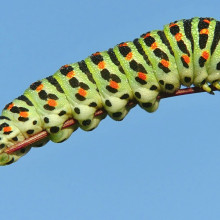
15:28 - Captivating Caterpillars
Captivating Caterpillars
with Dr Hannah Rowland, Cambridge University
This week we're asking what's the most amazing animal? Talking to Ginny Smith, Cambridge University's Hannah Rowland investigates how predators and prey animals evolve to try to outsmart each other...
Hannah - I chose to talk about caterpillars because I think everybody here will have heard the story of the very hungry caterpillar. So, I'm here to tell you that not only do caterpillars turn into beautiful butterflies, but they can eat more than Homer Simpson, they're stronger than the incredible hulk, and they're stronger than Nick's moles. They've got vision better than superman and they've got self-defences that Captain America would be really jealous of. So first of all, supervision like superman. So, we all know superman can see through walls. Well, caterpillars have got 12 eyes and they can see in a whole other dimension to us. They can see in the ultraviolet. This helps them find plants and helps them find the seeds that they start to eat. Then there are caterpillars that hide from their predators. They pretend to be something they're not and the black swallow tail caterpillar resembles bird poo. Now, if I was a bird, I don't think I'd want to eat my own bird poo, so this is a really good defence that I think any superhero would be really, really proud of. Caterpillars eat - can you believe this - more than Homer Simpson. They eat 27,000 times their own body weight in leaves in the 4 weeks that they're caterpillars. Now, that's the same as Nick, eating 68 cows.... a day!
Now, the strength - caterpillars have more muscles than the incredible Hulk. We've got 600 muscles in our bodies and caterpillars have got 4,000! They can keep hold of branches, and when little birds find them on trees, they'd cling on really tight so that the birds can't predate them. And the peppered moss caterpillar looks like an oak branch or a birch branch that they rest on. And so, when little birds are hopping around the trees like they are at the moment, they just don't see them. They just think, "Well, that's a branch. I'm not going to bother eating that." And the caterpillars survive by these wonderful visual defences. Now, some of them have more than one defence and the puss moth caterpillar has quite an arsenal of defences. When it gets disturbed and it thinks it's really in danger, it puffs up its head and it reveals this bright red face with black fake eyespots. If that wasn't enough, it has this tail on its end that it whips at the predator right over its head. On the top of this tail, they have little red barbs that when they whip them at the predators, they really, really are very smelly. And if that wasn't enough.. then they squirt acid at them. Now, some caterpillars have evolved conspicuous and bright colour patterns and this is because they're very, very poisonous. Some caterpillars are hairy. They look like somebody has shaved their moustache off and I don't think anybody would want to eat something that's hairy. I think it will be quite tickly in your throat. Now, the snake mimic caterpillar I think is the best of all. So, when it thinks there's danger, it puffs up its head into this diamond shape and on the underside, it has fake eyes like a snake. When you get really, really close to it, it even wobbles its body to make you think that it's going to pounce and give you a venomous bite. So, caterpillars are strong, they eat absolutely loads, they have really cool vision, they can see in a whole other dimension to us and they also are the masters of disguise. They can pretend to be things that they are absolutely not.
Ginny - There's another way of doing it where you can pretend to be really poisonous rather than actually being poisonous because of course, creating the poison costs something whereas if you can just look a bit like something poisonous, then you can get away with it. The same way that we might stay away from a hover fly that we see rather than swatting at it because we think it's a wasp. So, are there caterpillars that do that?
Hannah - There are lots of caterpillars that really play a game of bluff.
Ginny - Now, you've brought along a demo tonight to actually show a little bit about how this can work.
Hannah - I like more than one volunteer. I'd like people who think they'd be really good little birds.
Ginny - What's your name?
Theo - Payo.
Ginny - And your name?
Adam - Adam.
Hannah - I want you to be like a little bird and these are your caterpillars, okay? So, these are chocolate revels and we all know that there are some nice ones in here and there are some pretty grotty ones...
Ginny - Okay, so revels are a type of chocolate where they're all sort of similar sizes. Some of them look a bit more round than others, some are a bit more elongated. And some of them are a bit bigger, some of them are a bit smaller. When you dig in there, you might get a Malteser, you might get a chocolate covered raisin, you might get chocolate covered orange ball, or you might get chocolate covered coffee ball. Which one of those do you think sounds good?
Payo - The Malteser one.
Ginny - Which one sounds bad?
Adam - I would say probably, the coffee one.
Ginny - Okay, so we want Maltesers. We don't want coffee. But you don't know which is which so you're just going to have to guess.
Hannah - Take a couple of them.
Ginny - What was that one?
Payo - I think it's coffee.
Ginny - Oh no, bad luck!
Hannah - The poisonous caterpillar, no!
Adam - Orange. It's quite nice actually.
Ginny - Okay, so orange is a good tasting caterpillar. So, what you might want to do is start paying attention to what they look like because then when you go back for more, you'll be able to get one that you like. What else have you had?
Adam - I also had the raisin and the orange. And the raisin one is now the best.
Ginny - So, I can see that you are going repeatedly for the small sort of nobly ones which we know are raisins and actually look very different from the others. So because you like those, you're going for those again. What exactly does that tell us about caterpillars?
Hannah - Well, it tells us that if you are a caterpillar who's faking it and doesn't have any chemical defences or toxins that it actually pays a lot very different to something that is very palatable or it pays you to actually start to look like something that's really, really disgusting. It would be really, really good for us if our predators decided that a particular shape or a particular colour really wasn't ever worth attacking.
Ginny - So, if you'd had some white chocolate ones in there and no one liked white chocolate, they'd be very easy to spot. So, if you wanted to pretend to be white chocolate, that would work really well.
Hannah - Yeah and that's exactly what we see in nature. It's called mimicry.
Ginny - Thank you so much, Hannah Rowland. Judges, what did you think about that?
Max - I was just going to say, it's pretty impressive that you managed to talk for all that time about caterpillars without ever mentioning butterflies. It's very well-done.
Georgia - And I'm looking forward to the new Marvel film, Captain Caterpillar.
Ginny - Our judges are ready with their scores. So, over to you guys.
George - 7.... and a half
Georgia - I'm going to give them a 9.
Max - I'm also going to go 9.
Ginny - Strong stuff there. A round of applause for Hannah Rowland.

Crafty Grackles
with Dr Corina Logan, Department of Zoology, Cambridge University
This week we're asking what's the most amazing animal? Talking to Ginny Smith, Corina Logan, from the Department of Zoology at Cambridge University, works on 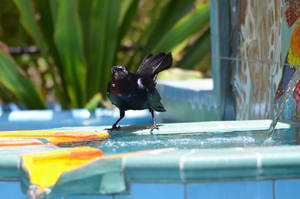 intelligence in birds, including the grackle. First she wanted to test the intelligence of one of the audience...
intelligence in birds, including the grackle. First she wanted to test the intelligence of one of the audience...
Will - I'm Will.
Corina - So, I'm going to ask you Will, if you're going to be able to help me solve this puzzle.
Ginny - Okay, so you're just removing a drape that's been covering up a rather strange collection of objects you've got here on the table. So, we've got in the middle a tall glass tube which is maybe 8 centimetres in diameter and it's about half-full with water. It's about 25 centimetres tall and floating on the top of the water is a little red ball. And then around it, we've got a selection of objects. What kind of objects can you see?
Will - There's some foam, stones, corks, sticks, and leaves.
Ginny - All sorts of weird things. So, what have we got to do here?
Corina - If you can get the ball out of the tube then I will give you a chocolate bar or a piece of fruit leather. But you can't tip over the tube.
Ginny - So, all you can use is those two fingers, your front finger and your thumb has a little sort of pincer action, and you have to say if you can get that ball out, what are going to do?
Will - I think I'm going to put stones in the bottom so the water rises up.
Ginny - Do you want to see if it works? Every time you're putting a stone in there, it's displacing some water and the water level is rising. So, what are you aiming for?
Will - That the water level rises enough so you can take the ball out.
Ginny - Well, done. You managed it. A round of applause. How do you actually go about doing this with a bird? I mean, you can't tell it to get a ball and swap it for chocolate, can you?
Corina - No, exactly. So, I actually have to train the birds to drop the stones down the tubes and I do this on a different apparatus. So, there isn't water involved. It's just a tube that's on top of a platform. So, you drop the stone down the tube and it collapses the platform and the food was sitting on top of the platform. So then it falls out when the stone goes through the apparatus.
Ginny - So, how long does it take them to learn it?
Corina - It depends. New Caledonian crows can learn it pretty quickly and in maybe around a hundred trials. Great tailed grackles, which is the species I'm promoting today, the fastest one was 165 trials and the slowest was like 392 trials... It took her a while.
Ginny - So, that's a little bit longer than it took our volunteer here who just took one look at it and did the right thing.
Corina - Yeah. So with humans, you can just say, get the reward and they don't need training in how to drop things down tubes because we have a lot of these kinds of experiences, but the birds don't.
Ginny - Why are you doing this with birds? I mean, it sounds like a lot of fun but I'm guessing there's a scientific reason.
Corina - Why I'm doing this particularly with the great-tailed grackle and for those who don't know, is because they're not a bird that lives over on this side of the Atlantic ocean. They're a bird and they're about the size of a jack saw but they have a really long tail, kind of like a magpie. With this particular bird, they actually have an average size brain for their body size while the crows and parrots have these really big brains and so, one of the ideas about brain size is that if you have a larger brain, you should be smarter. But these grackles, I first found them in Costa Rica. I was studying other animals there and I saw these grackles and they come right up to me and they look me in the eye. I think they wanted my food but I also thought, gosh! They look really smart. What I'm finding which is pretty amazing is that even though their brain is, it weighs as much as a 1p coin, they can solve these problems like children that are 5 years of age and older whereas children that are 4 years old, they don't solve these tasks. And they solve them like the large-brained new Caledonian crows and rooks, and Eurasian jays.
Ginny - Yes, so we've known for a while that these other birds that you mentioned, rooks and jays and crows are really, really intelligent. But we've always thought that they have very big brains compared to their body size and that that was why. But this is really throwing all that into the air. These animals have 1p coin. That is tiny. How come they can do this?
Corina - So, the neurons are how the brain is cognitively processing things. So, if you have more neurons, you should be able to do more things cognitively. And so, they have been finding that the number of neurons in your brain does not scale with how big your brain is. So, you can have a very large brain but not very many neurons. I think it's going to come down to looking at how many neurons different species have so that we can make better predictions about how smart an animal should be.
Ginny - Do we know anything about how many neurons your grackles have yet?
Corina - We do not. I'm waiting for some papers to come out this year. I've been waiting and waiting, and I'm really excited to see the results, but we don't know yet.
Ginny - So, it may be that packed into that 1p coin, they've got loads and loads - these cells which are actually doing the work, talking to each other and that's what allows them to be so intelligent.
Corina - Right, exactly.
Ginny - Thanks so much. That was Corina Logan everyone. Before we get to the judges, it looks like we have a question from the audience. What is it you want to ask?
Young Boy - Didn't they do some sort of study about birds using like a wire or a piece of metal to hook their food out of a tube like that?
Corina - Yes, good memory. So, this was work that was at Oxford with the New Caledonian crows. They not only used tools, but they make a lot of different kinds of tools. One of the kinds of tools they make is this hook tool out of sticks. Now, there's another species that's here, the rooks, and they are also able to do this. So in the wild, rooks don't use tools. They don't make the tools, but you bring them into an aviary and you give them a straight piece of wire, they'll make a hook and they'll pull the basket out.
Ginny - Amazing! Over to the judges now. Has anyone got a comment or question for Corina?
Max - You mentioned a few other tasks that crows could do and if you're saying that these birds are really smart despite having tiny brains, have you found any other tricks that they can do?
Corina - So, the grackles are different. They're not tool users and I did check for some tool use in the lab and I did not see that. They tend to flip objects over and look under rocks and things for food as well as digging in our garbage and eating at our outdoor cafés. They love chips and so, as soon as you turn your head, they're on the table, stealing your chips, so they can fly away and eat them. So grackles have slightly different strategies than the crows have.
Ginny - So, watch your chips if you're near a grackle. Okay, let's go over to our judges for your scores now. Let's start with George.
George - 7
Georgia - I'm going to go with 6.
Max - I kind of think you made crows sound more cool than grackles so I'm going to 6.
Ginny - Okay, a round of applause for Corina Logan. Now, let's go over to Heather to see what that's done to our leader's board. Heather, how is it looking now?
Heather - So, our grackles seem to be flying south with 19. The sticklebacks are swimming downstream with 21.5. Caterpillars are crawling just behind our leaders, moles which are clawing onto victory with 26.
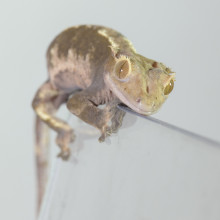
Gecko Glue
with Ewen Keller, TWI Ltd
This week we're asking what's the most amazing animal? Talking to Ginny Smith, Ewen Keller with us now who works for TWI Limited, studying what makes 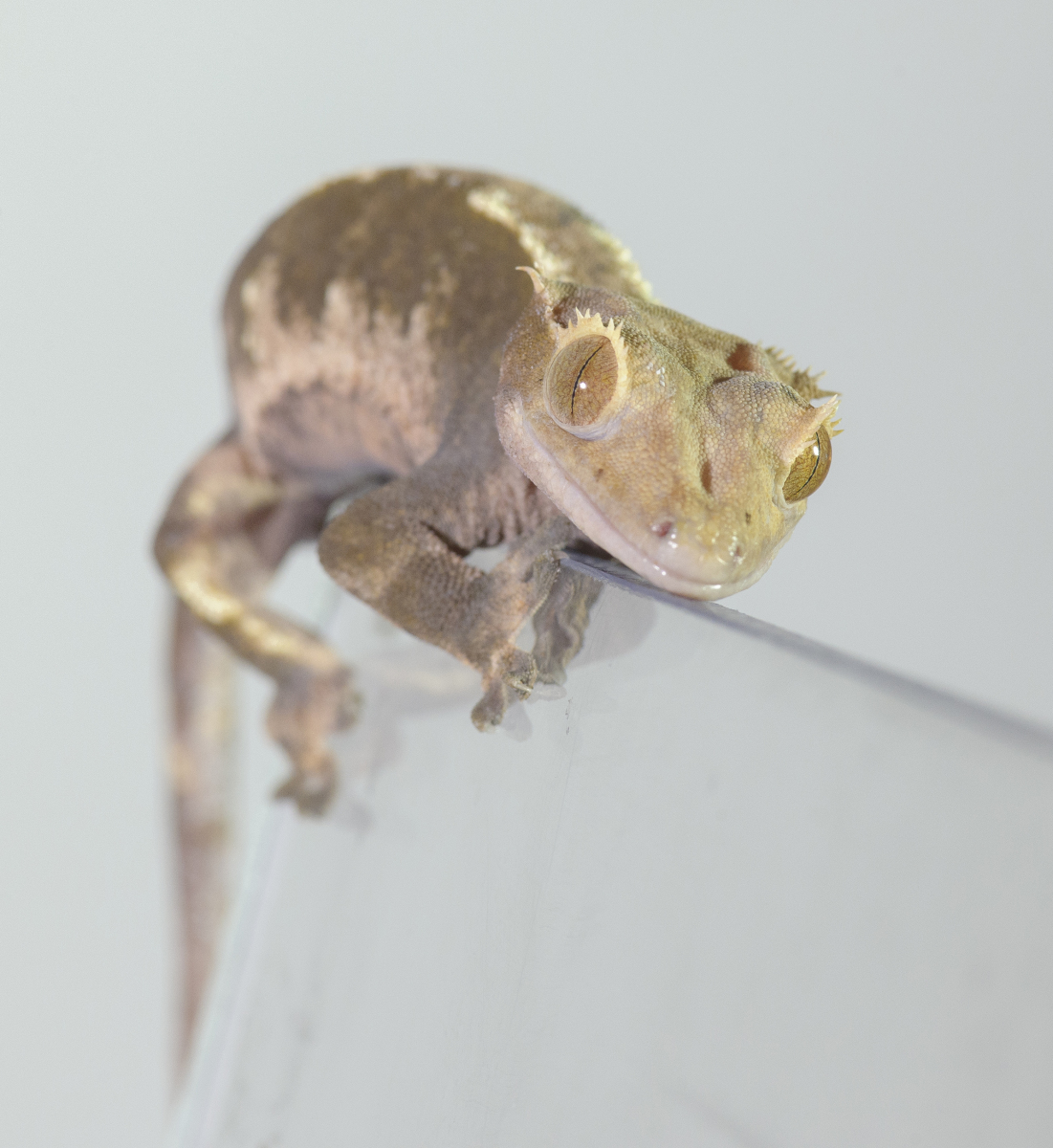 things sticky...
things sticky...
Ewen - Geckos are nature's best exponents of stickiness. An awful lot insects especially show how you can stick to things, flies, walking around on ceilings and up glass panels, and also, various plants also use stickiness to catch their prey like sundew in the bogs. But geckos do it in a completely different way. Their stickiness is what's called dry adhesion. So, they leave no mark after they've gone. So, they're not using any sticky compound like the glue you would have used in the classroom. Now, geckos are also pretty cool because they're really cute and they run around. They don't have any eyelids so they tend to just lick their eyes when they need them cleaned which is quite fun to look at. But what really sets them apart is the fact that they can literally walk up walls. They are nature's Spidermen if we're going to use the superman analogy that's already been used. Probably a lot better than Spiderman actually. Geckos have been around for a very long time, over 100 million years. We actually know that they could walk up things 100 million years ago because they've actually found some fossilised in amber and they can actually see they're on their feet. They still have the same structures, the same type of skin that allows them to do this. Basically, until about 2002, nobody really fully understood how this happened. So, what we're now talking about are geckos harnessing the laws of physics. So, they actually got a really good scientific head on to actually capture and use the forces of nature at the smallest level, what we call the nanolevel. If you take a millimetre divide it by a thousand, you get a micron. You divide that by a thousand again, you get a nanometre. So, we're working at a very, very, very fine level. What they found when they looked at the gecko feet under the microscope - it was the electron microscope - they found that on their feet were tiny hairs. These hairs which are called setae, whilst these are little hair-like structures on the ends of these little hair-like structures, there were even smaller hairs. These smaller hairs are called spatulae and basically, if we try and get some idea of scale, if you take a setae, you can get 14,000 of them on one square millimetre. On top of each of these setae, you can get about 500 spatulae on top of that. So, you can imagine, it's basically a column with tiny little hairs on which you get even finer hairs on. These tiny little hairs use a force called van der Waals forces which are all around us. And in fact, we use them and we experience them in terms of friction amongst other things when you want to hang on to something. But what this allows a gecko to do is, it allows these tiny hairs to get very close to the surface of glass or the ceiling or a tree or a leaf. And the natural forces, these natural harnessing of physics actually enables them to stick. Now, they don't actually need to stick very significantly because most geckos are quite light. They're about 20 grams actually, a lot of them. But if you could harness every single one of these spatulae, one gecko, with all his fingers and all his toes could actually take a weight of 133 kilograms that's two human beings.
Ginny - So, could you hang off a gecko?
Ewen - If the gecko was properly attached, yes. But I don't think they'd thank you for it!
Ginny - Now, you've been talking about how the geckos can produce these amazing forces. But we've got a demo here that's going to show everyone how powerful friction can be. So, what have we got here?
Ewen - What we've got here are two books which you imagine, they open ends facing one another where each page is interleaved with the other to actually then give a really large surface area of the paper in contact with the other book to enable the maximum amount of friction to occur.
Ginny - So, the two books that goes page from book one, page from book two, page from book one, page from book two, all the way through. So, they're touching over 200-odd pages. Who thinks they're quite strong? Okay, what's your name?
Gavin - Gavin.
Ginny - And your name?
Davin - Davin.
Ginny - Gavin and Davin, okay fantastic! Now, what we're going to do is we're going to have a little tug of war between you two. So, if you stand facing each other and one of you is going to hold on to the spine of this book and the other one is going to hold on to the spine of the other book. When I say go, I want you to pull. Okay, ready, one, two, three, go!
You don't look like you've made any difference to that book. Were you pulling as hard as you could?
Gavin - Yes.
Davin - I think it might be just glued.
Ginny - You think it might be glued. He doesn't believe me. Okay, now Georgia is having a go. It's really, really difficult and that is the same idea as the gecko's.
Ewen - In principle, yes. It's about getting literally the atoms of the surface close together between one surface in the next that allows this special attraction called Van De Waal's forces to actually work. It's all pervasive with the gecko that all the gecko needs to do is, it just sort of stops and he can hang on for hours.
Ginny - So, he's not using his muscles to hold on to the wall.
Ewen - Not at all. But one question that no one's asked is how then do they unstick which I suppose I better explain because basically, I called these tiny, tiny hairs spatulae. So, it's like a spatula in cooking, a bit like a wooden spoon with a big flat end. And that's the structure of these tiny little features is they've got this little angled foot. And basically, what it means is when the gecko actually climbs, it cools down a little bit and then it sticks. When it wants to move on, it lifts and peels them off. It can peel it off with virtually no force.
Ginny - So, I just saw Georgia just checking that I hadn't glued it and unpeeling each layer of the book and it does. It just unpeels very, very easily and you can see that it's not glued. That's the same thing that the gecko is doing again.
Ewen - Absolutely.
Ginny - Ewen Keller, thank you very much. Time to hear from our judges now. Who's got a comment or a question for Ewen?
Georgia - Firstly, do the geckos have to be alive for it to work?
Ewen - The phenomena works with the geckos being well and truly dead, as well as being alive though they can't obviously move their feet themselves.
Georgia - I'm wondering. Can I strap some geckos together and make gecko gloves and climb up buildings?
Ewen - Well again, this is virtually a reality now. They're already are starting to show synthetic versions of this where a man has been demonstrated to climbing up a glass wall. It was only a year or so ago. So, the world of Spiderman is going to become a reality.
Max - It's incredible that geckos can do this, but I've done some work in the tropics. I've definitely seen a gecko fall off the ceiling. So, if they're so strong, how can they fall off?
Ewen - Well I guess, like anything, there's always clumsy geckos out there. If it's a very, very wet surface then the adhesion will drop off. So, it could be that it was just a very, very wet area.
Gavin - Does it share this sticky thing ability with the tree frog?
Ewen - It's true to say that there are other some other reptiles and maybe some amphibians who have a similar property. It's predominantly the geckos, but it isn't unique to geckos. There are some other lizards that would do it.
Ginny - If our judges are ready, can we have your scores please.
George - 7
Georgia - Big fan of the geckos, I'm going to go with an 8.
Max - 7.
Ginny - One final round of applause for Ewen Keller.
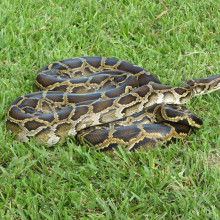
38:52 - Seriously impressive snakes
Seriously impressive snakes
with Beth Berry, freelance Science Communicator
This week we're asking what's the most amazing animal. Talking to Ginny Smith, Beth Berry, a science communicator and herpetologist with a 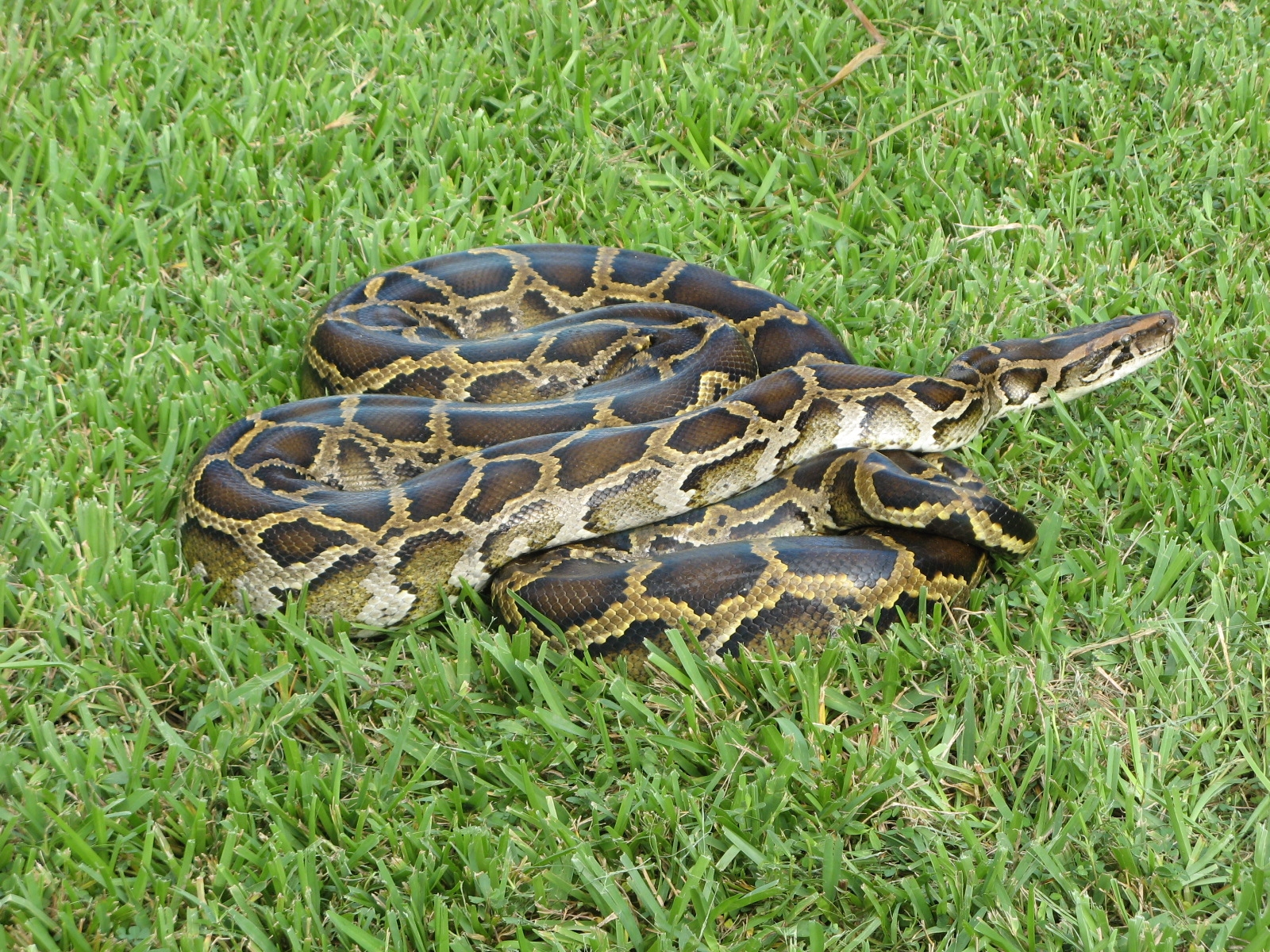 penchant for pythons...
penchant for pythons...
Beth - Yes, absolutely. I really love snakes. I think that they're phenomenal animals and today, I'm going to be talking about the amazing ways in which they eat. So first of all, I do have a question. Who would like a free dinner? Quite a lot of hands gone up. Well, I'm going to tell you now what you have to do. I have here a watermelon and whoever can eat this watermelon - good old steakhouse challenge gets - it for free. There are two rules. One is, you're not allowed to break, cut it up or chew it. So, you have to swallow it whole. We've still got one volunteer and you've got to do it without choking to death in the process. But what I'm here to tell you is that if there was a snake that was the same size as you, that had a head or jaw the same size as yours, it would have absolutely no problem with this. Snakes can swallow things that are much bigger than the size of their own heads or even thicker than the width of their bodies. A lot of people have heard the gold old myth that when snakes are eating, they unhinge their jaws. That is not quite correct. The truth is that their jaws are hinged in a very different way to ours. Whereas we have the little hinge at the back of our jaws. If you put your fingers up, you could probably feel it as you open and close your mouth. With snakes, it's very different. First of all, they have two hinges right there and a small bone in between them. That allows them to extend their gape. If you now take your finger and touch the bottom of your chin just right in the middle, have a feel around to the bone there, you can probably feel sort of slightly lumpy shape right in the middle where the lower left and right jaws meet. They're fused together by a bone. In snakes, that does not happen. The lower jaws on the left and right side are separate. They are not connected at all except by soft tissues or by skin and very stretchy ligaments which means that not only can the snake open its mouth a lot wider, but the lower left and right jaw can actually spread out from each other. This means that snake can take in food that's much larger than the size of its own head when its mouth was closed. But then we still have several problems with swallowing such a large meal. First of all, it's very, very fragile, this structure, with the many bones and the many joints. That means that it can't really bite or chew its meals. So it has this really, really clever mechanism. The teeth, they're curved around and they point towards the back of the mouth. And as the snake opens its mouth and starts to get it around the food, the left hand side of the jaw will release slightly and slide forward over the food. Once it's further forward than the right side, it will dig in and grip on tightly. Then as it pulls back, the right side releases slightly and pushes forward over the food, grabs on again tightly and it starts to pull back. And this repeats many times, this sort of ratcheting mechanism, to slowly pull the food down into the gullet of the snake. Because the skin is so elastic, it's rather like if you stuck a tennis ball down a sock, you see a large lump in the middle of the snake after it's eaten.
Ginny - You've actually brought another couple of guests along with you. Who have you brought?
Beth - We have Mandy here from Luton Reptile Rescue and she has brought two of her wonderful pets with her today. So, there's the rather small royal python called Sharka.
Ginny - Hi, Sharka. So, he's about 4 feet long. He's got beautiful scales - mottled brown and beige and he's now just winding his way up my arm.
Beth - If we look at Sharka's head and say, his head is less than 2 inches long, about an inch wide at the widest point.
Ginny - Yeah. It does look very tiny. So, what kind of animals would he be able to eat?
Beth - He would be able to eat rats.
Ginny - Wow! Now, we've got another bigger snake here. Does anyone want to come up and meet him? What's your name?
Freddie - Freddie.
Beth - This is Tsotsi Burmese python.Totsi is quite a bit larger. Tsotsi is about 10 foot long. He weighs about 20 kilos. So, you're absolutely welcome to touch.
Ginny - What does he feel like?
Freddie - Smooth, very smooth.
Ginny - I'm now wearing him as a feather boa. He slightly feels like he's tightening around my neck which I'm thinking is maybe not the best idea.
Beth - No, you're just his ideal radiator.
Ginny - They're very cold to touch, but they're not at all slimy. They're smooth and scaly. I might have to give him back. He keeps trying to lick my ear which is a little bit distracting. So, Freddie is now going to hold the small one. We're putting him around his neck. How does that feel?
Freddie - Very nice.
Ginny - So, he's just draping himself across your neck. They do feel beautiful don't they?
Beth - Yes, they have very, very smooth scales. They also keep themselves very clean. So, if you like a nice clean house, a snake is a perfect pet for you because they're fastidious about personal hygiene.
Ginny - And I believe they don't need feeding very often.
Beth - No, absolutely not. One of the reasons that they eat such large amounts when they can is that they really don't eat very often. The only reason that they eat is to get the nutrients that they need in order to grow and repair any injuries that they might have.
Ginny - So unlike us, you have to eat in order to just stay alive. They only need to eat so that they can grow and heal.
Beth - Yup, pretty much. So, they don't need to eat very much at all.
Ginny - We've got a question from the audience.
Male - Could Tsotsi eat the watermelon now?
Beth - So, if we look at the size of Tsotsi's head...
Ginny - So, he's about 2 inches long and an inch wide. At the biggest, maybe an inch and a half at the biggest point but by the time you get down to his nose, he's only less than an inch wide.
Beth - But he could quite easily, if he want to take out his jaws over this watermelon. The foods that he eats often are decently large rabbits.
Ginny - Okay, I think we should probably say a huge thank you to Mandy from Luton Reptile Rescue. Let's go over to the judges and see what they thought about that.
Georgia - We're getting acquainted with Sharka. I'm absolutely enamoured.
Max - In the process of playing with the snake, you can really feel the strength in the muscles of the snake. Are there any other ways that snakes kill their food before then managing to cram it in their face?
Beth - You do primarily get the venomous snakes and the constrictors. In terms of the constrictors, what they do is they tend to wrap around the ribcage and they can feel very well the heartbeat of what they've wrapped around. They will continue to constrict until that heartbeat stops. What they do is rather than just simply squeezing you until you can't breathe, as you breath out, they will tighten and then they will use all that muscle to hold you very still so that you can't expand your ribcage to breathe in again. And then as you try to breathe out more to give yourself some room to breathe in, they tighten again. And that is how it works. When I say you, obviously, I don't mean you as humans. I mean, the small animals that they tend to prefer to feed on.
George - With the venomous snakes, if they poison their prey, how come they eat it?
Beth - There are two things to think about. One is that a lot of venoms are only harmful when injected into the bloodstream. So, you can actually consume them by swallowing them down into your stomach and it wouldn't harm you. Another reason is that as you know, for a lot of snake bites, a lot of venomous bites, we have developed anti-venoms and these are actually often developed from the poison glands of the snakes that produce those venoms because they contain biochemical molecules that can protect you from the negative effects.
Ginny - Okay, I think it's time to get the scores from our judges please.
Georgia - I'm going to give snakes an 8.
George - 7
Max - And another 8 definitely for actually getting to meet the snakes is incredible. Thank you very much.
Ginny - A round of applause for Beth Barry on the snakes. Now, I think it's about time we have an update. We've only got one animal left to compete. So, how is our leader board shaping up, Heather?
Heather - Well unfortunately, it seems like our grackles stayed on the other side of the pond with a 19. Our sticklebacks are still heading downstream with 21.5. Our geckos are stuck in 4th place with 22. Because our snakes slithered ahead into 3rd place with 23. Again caterpillars, an inch behind with 25.5. Our leaders, the moles dug in for victory with 26. But could our final animal swoop in to take the victory?
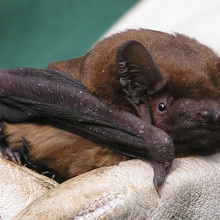
47:47 - Brilliant bats!
Brilliant bats!
with Jade-Lauren Cawthray, Natural History Museum, London
This week we're asking what's the most amazing animal. Talking to Ginny Smith, Jade Lauren Cawthray is an ecologist, citizen science practitioner and bat enthusiast...
Lauren - Well, some of my competitors this evening have already mentioned how their amazing animals should kind of have similar powers or interesting features that super heroes have. But my amazing animal actually has a super hero named after it which makes it especially cool - batman. And they are found across the world in every single type of habitat or part of the world except for the Polar Regions, where it's too cold and there aren't any insects that they can eat. Now I'm particularly fond of the British bats here in the UK and we have 18 species of bat here in the UK and 7 within Cambridge City. There are two major groups, two major types of bats. We've got the mega bats which are humongous bats with dog-like faces, big eyes and little ears. Most of them are eating fruits. Some of them like to eat nectar from plants and then we have the micro bats which are usually the smaller bats. They have big ears, little eyes, and are often insect eaters. And all the bats here in the UK are the micro bats. They're all insect eaters. Now, the size of bats varies hugely. The biggest bat in the world is a flying fox and it has a wingspan of 2 meters. So put your arms out, stick your arms out side to side. The flying fox is bigger than your arm span. It's humongous and it can fly straight out into oceans for long, long distances. The smallest bat in the world was relatively recently discovered and it's called the bumblebee bat and it is as small as your thumbnail.
Here in the UK, of our 18 species, our smallest bat, the pipistrelle bats, we've got a common pipistrelle and a soprano pipistrelle. They're about 23 centimetres wide and the biggest bat in the UK is the noctule bat which has a 40-centimetre wingspan. So, it's quite substantial and you see them flying high across hedgerows and treelines here in the UK. Bats do some incredible things. Some of the most amazing things includes hibernation and echolocation. So, hibernation is particularly important for bats that live in temperate environments, like ours here in the UK, where you have seasons, you have a hot summer; you have cooler autumn; really cold winter; and then a lighter spring. And because during that winter period, there aren't any insects available for them to eat, they need to go to sleep. And they need to get their body temperature really, really, really low so that they're not using energy because there's no food to replace that energy. So, they slow their heart rate down to 4 beats per minute. And this means that they can get their metabolism down and make sure their body temperature is the same as the air temperature and that means then they're not losing energy by heat into the atmosphere, and can save as much fat through the winter to try to get them back through until the spring comes. Certainly here in the UK, they'll start to go into hibernation about October time and they'll hibernate all the way through until about March time. So, our bats have started to fly around again and started to feed again.
Now, here in the UK, once the insects start coming, they can start getting out again and the females are really, really hungry because inside the females, they are now starting to grow baby bats inside of them. So they have to start eating lots and lots of food. A colony of about 100 pipistrelle bats can eat up to 1 ton of insects in a single evening. The female bats, the baby inside of them can grow to 50% of their body weight. In about August time, it gets quite exciting because then the babies are born. The babies at first, they drink milk from their mothers. They have milk teeth first and those milk teeth will drop out and they'll replace them with insect eating teeth and then they'll start to come out and fly and feed with the other adult bats. At that point, the mums and dads start to socialise again. They've been keeping themselves separate. Mum's been busy looking after the babies and then the mums and dads start to get together. They start to go and have a nice dinner for two over in a branch and a tree somewhere and then something very exciting happens. The male bat gives the female bat a special cell. The female bat keeps that cell in her body throughout the whole of the winter. The egg cell and sperm cell aren't joined yet. They stay separate in her body. And when the temperature rises again, she then makes fertilisation occur in her body and the sperm cell and the egg cell meet. It's at that point that then she's able to grow the baby. This is a really important strategy for survival because during that winter period, there is no food available for her to grow that baby bat. So, she needs to stave off that process of growing a new young bat inside her until there's food available, which I think is an incredible strategy. So, just a couple of amazing things. I should probably also mention that bats are the only true flying mammal in the whole world which makes them pretty cool. But they also have another extra special feature which we've got an audio recording of...
Now, you might just have heard that crackling then popping sound. Now, that is the sound of a bat. What we've done with that recording is we've taken a bat detector out into the field and the bat detectors recorded the noise that the bat is making. But then the bat detector does a special calculation to turn that noise into something we can hear because bats, their echolocation calls and many of their social calls are really high pitched, at a frequency our human ears can't hear. And so, that noise is the right pattern that is actually going on outside all of the time, but something scaled down to what we can hear. What the bats are doing is they're giving humongous shouts out to their environment and the shouts are so loud that they can deafen themselves. So, they actually have to detach their ears so that they don't deafen themselves when they shout. And then that noise bounces off the environment and depending on how far away an object is from them, that depends on how quickly the sound comes back and then their brains make a calculation about the distance to the nearest tree, the distance to the nearest wall. But the sound and the complexity of those soundwaves is so fine that they're able to determine shapes and features as well which means that a pipistrelle bat, our 23-centimetre long bat is able to find tiny little gnats and mosquitoes in a whole field of trees and leaves and other insects and moths flying around.
Ginny - Those are some amazing abilities - to be able to fly, to be able to see in the dark with sound. I think bats have a good chance of giving the other animals we've talked about tonight a run for their money. But let's go over to the judges to see what they think.
Georgia - Thanks, Jade. You mentioned batman. I love this idea of an actual batman like, think how much better Ben Affleck would be if he was fluffy, squeaked loads and could detach his own ears. I would watch that film.
Max - I just wanted to ask you a little bit more about detaching their own ears. Just how?
Jade - You know like within our ears, we have three little bones. Well, they've got the ability to separate those for a fraction of a second while that shout goes out.
Ginny - In our human ears, to conduct the sound from outside to inside, as Jade says, there are three bones which connect to each other. The air pushes our eardrum, that pushes one bone, and pushes the next bone, pushes the next bone, and that's transmitted off into our brains. So, if you separate two of those bones, that information can't get from the outside through to the brain. So, I think that's right. That's how that works.
It's time for our judges to give their final scores of the night. Over to you guys...
Max - 8
George - 8
Georgia - 10

55:54 - The Sticklebacks Return...
The Sticklebacks Return...
with Jolle Jolles, Department of Zoology, Cambridge University
This week we're asking what's the most amazing animal? Jolle Jolles, a PhD student at the department of 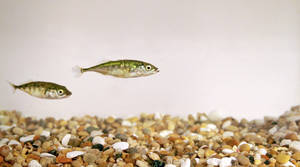 zoology at Cambridge University, explained to Ginny Smith why sticklebacks deserve to be crowned kings of the animal world. Here returns to an experiment he set up earlier...
zoology at Cambridge University, explained to Ginny Smith why sticklebacks deserve to be crowned kings of the animal world. Here returns to an experiment he set up earlier...
Ginny - Now, it's very nearly time for our final scores but before we do that, we need to go back to Jolle and see how your fish have done. So, if you remember, right at the beginning, we had some sort of goldish-brown coloured fish and we put half of them in a black tank and we put half of them in a white tank. What are they looking like now?
Jolle - They're very hard to find now, so it takes me a while maybe.
Ginny - What can you see?
George - One fish is black and the other one is white.
Ginny - So, they do look really different now, don't they?
Jolle - You can see that in this just one hour, these fish looked totally different from one another. And this is really great because this helps them to be camouflaged against their background. It helps them that all these predators that are out there will not find them as easily.
Ginny - So, if you look at them from the side, you can see almost stripes of black on the one that's been in the black tank whereas the white one is just very pale. Most of the colour seems to be focused on the top half of the fish. Their undersides, their tummies, are still kind of silvery. Why is that?
Jolle - Most predators are actually aerial. Imagine herons standing next to a creek. So, these birds, they look down. They try to find these fish. But if you look at them from above, this is when you see their back and this is the most camouflaged part.
Ginny - Do you want to show the judges and see if they'll give you an extra point?
George - No.
Ginny - What about you Max?
Georgia - This is a tough judge. I'm impressed.
Max - The experiment works. He'll definitely get his bonus point.
Ginny - One more bonus point for Jolle and then you the audience are going to make the final decision as to who the winner is out of our top 3. So Heather, can we have the final tally? Who are our top 3 animals?
Heather - So, our extra stickleback point didn't actually change, they didn't make the top 3. We have the moles dug in for victory with 26, but the bats swooped in for a tie-breaker and also have 26, with the caterpillars just crawling slightly behind - 25.5.










Comments
Add a comment